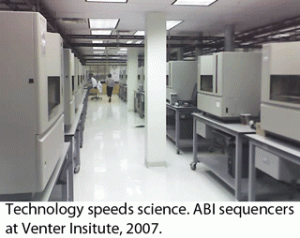Commercial opportunities
 The most successful technologies generate money. In turn, a commercial market helps drive improvements in cost and speed, enabling wider applications and new scientific knowledge. The rapid completion of the Human Genome Project (HGP) can be seen as a direct result of Applied Biosystems ABI 3700 DNA analyzer, the first fully automated capillary sequencer, introduced in 1998. In turn, the large market for high-throughput sequencing that resulted from HGP funding helped drive multiple rounds of improvement in cost and speed.
The most successful technologies generate money. In turn, a commercial market helps drive improvements in cost and speed, enabling wider applications and new scientific knowledge. The rapid completion of the Human Genome Project (HGP) can be seen as a direct result of Applied Biosystems ABI 3700 DNA analyzer, the first fully automated capillary sequencer, introduced in 1998. In turn, the large market for high-throughput sequencing that resulted from HGP funding helped drive multiple rounds of improvement in cost and speed.
This leads me to thoughts about DNA barcoding. The first exploratory meetings were held in 2003 at Banbury Center, Cold Spring Harbor Laboratory. Seven years later DNA barcoding is established as an accurate method for species identification with diverse scientific applications. BOLD, the publicly-available library of DNA barcodes, contains over 800,000 records from over 70,000 species. A new international effort, iBOL, is underway to establish DNA barcode libraries for 5 million specimens from 500,000 species by 2015. Like the government-maintained network of GPS satellites, publicly-funded DNA barcode libraries appear to offer enormous commercial opportunity, with potential benefits to society and science.
Where is barcoding on this path? So far, I find only a handful of companies and/or products that provide DNA-based species identification (for example, Therion, SteriSense, FishDNAID, Applied Food Technologies, Ecogenics). Of the few that exist, most are aimed at fish identification and do not take advantage of large scope and transparent sourcing of DNA barcode libraries. For example, Agilent Technologies recently introduced a “Fish identification system” based on “experimentally-derived [PCR-RFLP] patterns from more than 50 species.” This is wonderful but the scope is too small and the underlying library is unknown. Agilent is participating with the National Center for Food Safety and Technology, a US government-industry collaboration, so perhaps that will lead to more robust applications. I note that DNA barcode detection of food fraud (not just fish) was front-page news in Washington Post in March 2010 and the potential educational market is also large. I look forward to more entrepreneurs, whether at established companies or start-ups!
This entry was posted on Tuesday, July 20th, 2010 at 4:00 pm and is filed under General. You can follow any responses to this entry through the RSS 2.0 feed. Both comments and pings are currently closed.
July 20th, 2010 at 4:56 pm
Hi Mark,
In addition to those companies you list, EuroFins is now offering a DNA barcode ID service as well… I predict that the competition will only continue to increase. It is also perhaps relevant to note that the Biodiversity Institute of Ontario offers barcode identification and as the progenitor of the methodology and host of the BOLD database, represents perhaps the best available option for barcoding.
July 22nd, 2010 at 6:01 pm
Hi Mark. Agilent Technologies also offers a DNA barcode ID kit as well. You can find details here http://www.chem.agilent.com/en-US/Industries/chemicalanalysis/foodsandflavors/Pages/fish.aspx